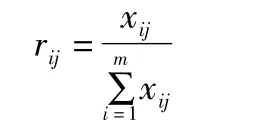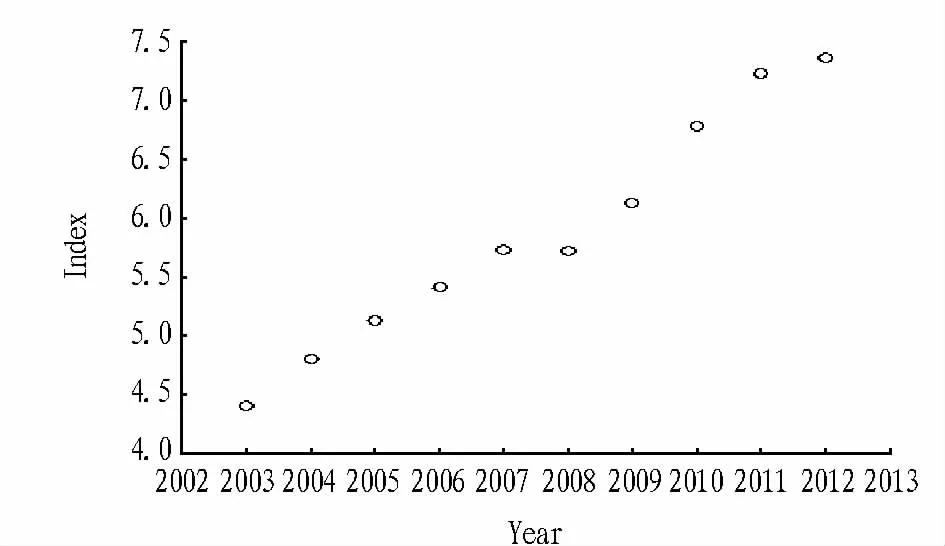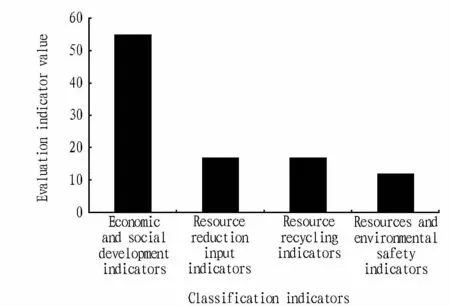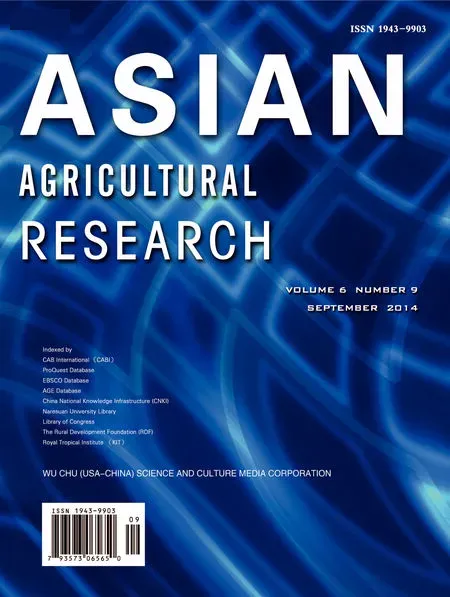Evaluation of the Development of Circular Agriculture in Chongqing City Based on Entropy Method
Fangying ZHOU,Shunqiang SUN,Guiying ZHU
College of Economics and Management,Southwest University,Chongqing 400715,China
Circular agriculture is a new mode of agricultural development combining theory of circular economy and theory of sustainable development,and a new way of agricultural economic growth to help achieve coordination of population and natural environment[1].The development of circular agriculture sticks to the principle of 3R(Reduce,Recycle,Reuse),and it includes the economic system into the natural ecosystems,which plays a key role in solving the problems in the development of traditional agriculture,such as waste of resources and low level of industrialization[2].
Chongqing is situated at the transitional area between the Qinghai-Tibet Plateau and the plain on the middle and lower reaches of the Yangtze River in the sub-tropical climate zone often swept by moist monsoons.Chongqing covers a large area crisscrossed by rivers and mountains,and the average elevation is400 m.Chongqing has a monsoon-influenced humid subtropical climate,with annual precipitation of1000 to 1450mm,and average annual temperature of 15℃.It has favorable natural conditions,but the level of agricultural development is low,the economic efficiency is poor,and the pollution is serious.
In fact,the contradictions between agricultural development and ecology are prominent.Chongqing City is national coordinating urban and rural demonstration area,featured by the pattern of"large city,large village",so this paper chooses Chongqing City as the research object.Using the methods of literature research,model evaluation and statistical analysis,this paper builds the indicator system for circular agriculture in Chongqing City to research the current status of agricultural development in Chongqing City,and uses it as a logical starting point to present the main path to promoting the development of circular agriculture,in order to provide new thinking and reference for the development of circular agriculture in Chongqing City.
1 Building of evaluation indicator system for circular agriculture in Chongqing City
1.1 Design of evaluation indicator system for circular agriculture The evaluation of the development of circular agricultural economy in this article is based on the BPEIR conceptual model of Ma Qifang et al.
The following four aspects are believed to be involved:
(i)The economic and social development indicators;
(ii)The resource reduction input indicators;
(iii)The evaluation indicators for recycling of resources;
(iv)The evaluation indicators for resources and environment safety[3].
According to"3R"principle,combined with the actual situation of agricultural production in Chongqing City,this paper selects 15 evaluation factors as evaluation indicators.
This paper performs data analysis,in order to fully understand the current situation of agricultural development in Chongqing City and provide a reference for the development of circular agriculture(Table 1).
1.2 The evaluation methods for the current development of circular agriculture
1.2.1 Data sources.The data for the establishment of evaluation indicator system for the development of circular agriculture are mainly from the following aspects:
(i)The relevant economic data are from Chongqing Economic and Social Development Statistics Bulletin(2003-2012)and Chongqing Economic and Social Development Statistical Yearbook(2003-2012);
(ii)The relevant policies are mainly from the Chongqing Municipal People's Government website and Chongqing Municipal Agricultural and Rural Information Network.
1.2.2 Basic principles of entropy method and calculation steps.Assuming there are n indicators and m years to constitute the raw data matrix X=(Xij)mn.For indicator Xj,if there is a greater difference in the value of indicator Xij,then the role of this indicator is greater in the evaluation system,and if there is a smaller difference in the value of indicator Xij,then the role of this indicator is smaller in the evaluation system[4].

Table 1 The evaluation indicator system for circular agriculture in Chongqing City
In the information theory,there is the following functional relation:

If the degree of dispersion of value of one indicator is greater,then H(x)will be smaller,the amount of information provided by the indicator will be larger,and the weight will be accordingly larger[5].Thus,according to the degree of dispersion between indicators,using the information entropy to determine the indicator weight can provide the scientific basis for assessing the current status of the development of circular agriculture.
First,we normalize the data,and this article uses the normalization method[6].

And we determine the degree of influence of attributes on the decision-making goal-attribute authority[7].
Let the attribute weight be x1,x2,…,xn,and the weight vector be w=method is used to measure uncertain indicators,and see various column vectors of normalized decision-making matrix R[(r1j,r2j,…,rmj)T,j=1,2,…,n],as the distribution of the amount of information in the multi-attribute decision-making processing.
The entropy of the indicator attribute xjis calculated as follows:

The distribution is consistent,and the smaller the difference among r1j,r2j,…,rmj,the greater the entropy Eij.
We calculate the discrimination Gjof defined attribute Xjfor the evaluation system[8].
Gj=1-Ej
We calculate the weight of various attributes:the greater the discrimination Gj,the greater the weight wj[9].

Multiplying wjby the standardized indicator value rij,we get the circular agricultural development level index of subsystems Ui=wjrij[10].
We calculate the comprehensive evaluation indicator of circular agriculture,and this article selects the weighting function method:

2 Analysis of the results based on the evaluation system for circular agriculture
2.1 Analysis comprehensive evaluation results Based on the above method,this article carries out the comprehensive evaluation of the current status of development of circular agriculture in Chongqing City,and shows the relevant data in a chart form(Fig.1 and Fig.2).

Fig.1 The comprehensive evaluation results of the development of circular agriculture in Chongqing City from 2003 to 2012
As can be seen from Fig.1,since 2003,the agricultural development has shown good momentum in Chongqing City,and the level of comprehensive development of circular agriculture is constantly improved.After 10 years of development,the comprehensive evaluation indicator value of circular agriculture was 7.36 in 2012,about1.67 times that in 2003(4.40).
Fig.1 shows that the development of circular agriculture in Chongqing City from 2003 to 2012 can be divided into the following four stages:
(i)Rapid increase stage(2003-2007).The development of circular agriculture was remarkable.During this stage,the comprehensive evaluation indicator value was higher than in 2003,and the comprehensive agricultural evaluation indicator value was increased at an annual rate of 5.400%.
(ii)Basically stable stage(2007-2008).The development of circular agriculture underwent small changes.The comprehensive evaluation indicator value remained at a level of about 5.7,and it slightly declined to 5.696 in 2008.
(iii)Rapid development stage(2008-2010).The development of circular agriculture was rapid.During the period 2008-2010,the comprehensive evaluation indicator value showed continued growth trend,with a growth rate of 5.837%.
(iv)Slow development stage(2010-2012).The development of circular agriculture slowed down,with an average annual growth rate of 2.774%.
In order to further understand the development of circular agriculture in Chongqing City,this article uses the line chart to show the specific changes in the four major measurement indicators from 2003 to 2012.As shown in Fig.2,the four major indicators showed a rising trend;the value of resources and environmental safety indicators in 2004 was lower than in 2003,and the value of the remaining three types of indicators was higher than in 2003.
With the size of value of indicators for circular agricultural economy as the basis,the indicators are sequenced in descending order as follows:economic and social development indicators(5.865)>resources and environmental safety indicators(4.877)>resource reduction input indicators(3.731)>resource recycling indicators(3.184).
From the specific analysis of individual indicators,we can draw the following conclusions:
(i)The value of economic and social development indicators has been growing rapidly.The economic and social development indicators are positive indicators,indicating that since 2003,the development of circular agriculture in Chongqing City mainly has benefited from the economic and social progress.However,it can be seen from the figure that there is great volatility in this indicator,suggesting that the technology and policy needed by agricultural development have yet to be perfected.
(ii)The value of resources and environmental safety indicators shows an overall upward trend.As can be seen from Fig.2,except the small change in the indicator value in 2004,the value of resources and environmental safety indicators has been growing,indicating that the development of agriculture in this period focuses on the environmental protection and resource conservation.
(iii)The value of resource reduction input indicators from 2003 to 2012 always remained at a steady growth rate,but the overall level was below that of the economic and social development indicators.Resources and environmental safety indicators are negative indicators,and the smaller the indicator value,the greater the limiting effect on circular agriculture.The evaluation value of this indicator system is low,indicating that there is the high-input phenomenon in the agricultural development.
(iv)The value of resource recycling indicators was higher than in 2003,with great volatility.From Fig.2,it can be divided into the following three stages:
The first stage was2003-2010,when the change was relatively stable.Compared to previous years,the value decreased slightly in 2006,indicating that the recycling of resources in this year became a factor restricting the development of circular agriculture.
The second stage was2010-2011,when the value decreased rapidly,a decrease of up to 10.093%,indicating that the resource recycling during this stage seriously hampered the development of agriculture.
The third stage was2011-2012,when the value of resource recycling indicators showed a slow upward trend,indicating that the restraining effect of this indicator on agricultural development was gradually weakened.
Through the analysis of value of change in classification indicators,it can be found that the economic and social development has a great impact on the development of circular agriculture,and agricultural technology,agricultural industrialization and other factors still restrict the development of circular agriculture in Chongqing City;resources input reduction and resource recycling indicators also become the main obstacles to the development of circular agriculture in Chongqing City.

Fig.2 The evaluation indicator value of classification indicators for circular agriculture in Chongqing City from 2003 to 2012
2.2 Analysis of barriers to the development of circular agriculture The evaluation of the development of circular agriculture is a systematic project.On the basis of comprehensive evaluation,to find the factors hindering the sustainable development of agriculture,and effectively adjust the agricultural practices,there is a need to analyze the current status of agricultural development.
Specifically,we can use three indicators("factor contribution degree","indicator deviation degree","obstacle degree")for judgment,and the principles of all indicators and calculation methods are as follows[11]:
The factor contribution degree Ujsignifies the degree of influence of individual indicators on the overall objective,namely,the weight of various indicators in the evaluation system.
The indicator deviation degree Vjrepresents the gap between the individual indicators and the overall objective,signified by the difference between normalized value of individual indicators and 100%.

The obstacle degree Wjsignifies the value of influence of individual indicators and classification indicators on the overall level of objective,and this indicator is the diagnosis result and objective of barriers to the development of agricultural circular economy.

Through the ranking of the obstacle degree of individual indicators,we can determine the obstacle degree of various obstacle factors to the development of circular agriculture in Chongqing City in 2012,and the results are shown in Table 2.

Table 2 The obstacle degree of individual factors to the development of circular agriculture in Chongqing City in 2012
In accordance with the ranking of size of obstacle degree of individual indicators,the major obstacles to the development of circular agriculture in Chongqing City in 2012 were output value of agriculture per unit area,grain yield,the per capita net income of farmers,total agricultural machinery power,per capita food production,livestock commodity rate,Farming,forestry,animal husbandry and fishery commodity rate,effective fertilizer utilization coefficient,multiple cropping index,pesticide use level,plastic sheeting use level,per capita arable land area,forest coverage,effective irrigation coefficient,and chemical fertilizer application intensity.
Through the analysis,it can be found that the major obstacles to the development of circular agriculture in Chongqing City in 2012 were economic and social development indicators,resource recycling indicators and resource reduction input indicators.The top indicators are all individual indicators of economic and social development,indicating that the development of circular agriculture in Chongqing City is still subject to the current level of economic and social development.
In order to more clearly diagnose the main limiting factors during the process of development of circular agricultural economy in Chongqing City in 2012,this paper calculates the obstacle degree of four major classification indicators,respectively,based on the calculation of obstacle degree of individual indicators.The calculation results are shown in Fig.3.


Fig.3 The obstacle degree of classification indicators concerning circular agriculture in Chongqing City in 2012
It can be found from the figure that themajor obstacles to the development of circular agricultural economy in Chongqing City in 2003 were economic and social development indicators(54.83%),resource reduction input indicators(16.78%),resource recycling indicators(16.72%),and resources and environmental safety indicators(11.65%).
Therefore,under the current conditions for agricultural development,how to improve the level of agricultural development and reduce resource input in the case of the same output and lower the obstacle degree of recycling,is a prominent problem for the development of circular agriculture in Chongqing City.
3 The problems in the development of circular agriculture
Through the comprehensive evaluation of circular agriculture and diagnosis of obstacle degree,we can see that there are the following problems in the development of circular agriculture in Chongqing City:
3.1 The economic and social development indicators become the major limiting factors Output value of agriculture per unit area,grain yield,the per capita net income of farmers,total agricultural machinery power and livestock commodity rate are the major limiting factors.The output of circular agriculture is low in Chongqing City,and the commodity rate is not high.The agricultural development is still not completely out of the traditional agricultural development model featured by low output and low income.The main reasons are the low level of agricultural mechanization,and weak agricultural development momentum;undeveloped agricultural technology,and inefficient use of resources;inefficient market-oriented agricultural economy,and low level of combination of agriculture and industry.
3.2 The resource reduction input indicators become the important factors restricting the development of circular agriculture in Chongqing City The input of fertilizers,pesticides and plastic sheeting is too large,the technology is backward and the application efficiency is low,violating the concept of agricultural intensification and green development,increasing the cost of the development of circular agriculture.
3.3 The resource recycling indicators also become a major obstacle to the sustainable development of circular agriculture in Chongqing City Effective utilization coefficient of chemical fertilizer is low,and there is a shortage of studies on the different soil structure,plant types and regularity of application seasons.The resource use efficiency is never optimized.The multiple cropping index of agriculture in Chongqing City is also a major factor hindering economic development,and it is necessary to change the mode of production for the sustainable development of agriculture.
4 Recommendations for the development of circular agriculture in Chongqing City
4.1 Improving the agricultural infrastructure and promoting agricultural modernization Agricultural modernization is the requirement of transforming traditional agriculture to modern agriculture,and it is a tool for the development of circular agriculture.From the above analysis,it can be found that the output of circular agriculture is low in Chongqing City,and one of the important reasons is low level of agricultural modernization,and fragile agricultural development.So it is necessary to improve agricultural infrastructure,and improve the level of agricultural modernization.
(i)It is necessary to strengthen the cooperation between the government and large insurance companies,and purchase agricultural insurance for the agricultural production vulnerable to natural conditions and man-made factors,in order to reduce the loss of farmers and improve agricultural ability to resist risks.
(ii)It is necessary to promote agricultural information technology,improve agricultural production,marketing and supply management,and perfect the crop price information system,to promote market-oriented agricultural production.
(iii)It is necessary to increase government subsidies for agricultural machinery,and improve the total agricultural machinery power.
4.2 Building industrialization-based agriculture and improving the unit commodity rate The high commodity rate can increase the agricultural output value per unit area and increase farmers'income.As can be seen from the above analysis,the livestock commodity rate and total commodity rate of farming,forestry and animal husbandry and fishery,are the major constraints for the development of circular agriculture in Chongqing City,seriously affecting the development of agriculture.To improve agricultural commodity rate,it is necessary to accelerate the construction of agricultural industrialization.
(i)It is necessary to establish the"farmer-enterprise"business model.Local authorities should expand publicity and attract more enterprises to strengthen cooperation with farmers,to form the"farmer-enterprise"form of cooperation,and get higher commodity rate.
(ii)It is necessary to build and perfect the agricultural circulation market system,innovate upon the agricultural marketing mode and accelerate the development of network business model.With the gradual improvement of network technology,the network marketing is gradually being accepted.The agriculture in Chongqing City should seize this opportunity to build its own agricultural network sales platform.
4.3 Strengthening the science and technology input to achieve cleaner agricultural production Resource input reduction is in line with the requirements of modern agricultural development,and it is an inevitable choice of circular agriculture.As can be seen from the above analysis,there are the problems of waste and pollution of chemical fertilizers,pesticides,plastic sheeting and other resources during the process of development of circular agriculture in Chongqing City.
(i)It is necessary to vigorously research and develop the agricultural fertilizer-saving technology,reduce the application of chemical fertilizer and improve the utilization efficiency;improve the use standards of trace elements and meet the needs of soil for different nutrients.
(ii)It is necessary to strictly control the rational use of pesticides to ensure efficacy and improve the level of pesticide use;strengthen the accurate forecasting of law of pests and diseases and control conditions,and targeted and timely use of pesticides;adopt mechanical pesticide-saving technology and carry out the precision spraying operation,to improve utilization of pesticides.
(iii)It is necessary to solve the problem of residual plastic sheeting,reuse the plastic sheeting,and use biodegradable film,to avoid waste and pollution of plastic sheeting.
4.4 Following the ecosystem law and developing new circular agriculture Recycling of resources is a goal of intensive development of agriculture,and also one of the objectives of the development of circular agriculture.As can be seen from the above analysis,the resource recycling has become a major obstacle to the development of circular agriculture in Chongqing City.So it is necessary to follow the principles of ecology,and improve the efficient use of fertilizers and agricultural cropping index.It is necessary to strengthen the study of soil composition,fertilizer type and agricultural climate,and grasp the different application methods of fertilizers to improve fertilizer utilization and reduce the fertilizer input per unit area.
Due to a large mountain area,Chongqing City should vigorously develop new mode of circular agriculture and three-dimensional model of agriculture according to the local conditions,extend the industrial chain and increase multiple cropping index[12].
4.5 Strengthening the government guidance and building the circular agriculture The building of circular agriculture is a systematic project,and it needs the government's participation and guidance.
(i)The government should strengthen the service work,and provide policy support for the development of circular agriculture.Relevant departments should include the development of circular agriculture into the work plan,and introduce the relevant policies to provide institutional guarantee for the development of circular agriculture.
(ii)The government should strengthen the guidance work,help farmers to establish the concept of circular agriculture,introduce advanced technologies and provide technical support.
[1]CHEN SY,ZHANG LY,YAOYP.Study on the path of developing circular agriculture in four agricultural areas in western areas[J].Economic Research Journal,2013(5):33-36.(in Chinese).
[2]WANG GM,LUO J.Difficulties in developing modern agriculture in western regions and their countermeasures[J].Rural Economy,2007(12):41-44.(in Chinese).
[3]MA QF,HUANG XJ,PENG BZ.A positive study of the evaluation on the development of regional agricultural recycling economy[J].Journal of Natural Resources,2005,20(6):891-899.(in Chinese).
[4]QIAO JJ.Application of improved entropy method in Henan sustainable development evaluation[J].Resources Science,2004,26(1):113-119.(in Chinese).
[5]GUO XG.Application of improved entropy method in evaluation of economic result[J].Systems Engineering—Theory&Practice,1998,18(12):98-102.(in Chinese).
[6]JIANGQY.Comparison on main several methods for multi-attribute decision making and its application[J].Mathematical Modeling and Its Applications,2012,1(3):5-7.(in Chinese).
[7]PENG BZ,AN XD,CHEN F,etal.A study on sustainable land use in the Yangtze River Delta[J].Journal of Natural Resources,2001,16(4):305-312.(in Chinese).
[8]LEIQ,SUWC.On the study of the circular economy models in the mountainous area countryside of southwest[J].Rural Economy,2008,24(2):66-69.(in Chinese).
 Asian Agricultural Research2014年9期
Asian Agricultural Research2014年9期
- Asian Agricultural Research的其它文章
- Evaluation of the Agricultural Non-point Source Pollution in Chongqing Based on PSR Model
- Farmers'Willingness to Pay(WTP)for Reducing Agricultural Non-point Source Pollution:Based on the Empirical Analysis of 453 Farmers
- A Study of the Artificial Vegetation Restoration Technology in the Wenchuan Earthquake Area
- Evaluation of the Overall Level of New Urbanization in Hebei Province Based on Factor Analysis and GIS
- Empirical Analysis of the Typical Breeding Pattern of Clam in Hongdao Town and the Preliminary Estimates of Costs and Benefits
- Theory and Practice of Marine Regional Management in China
